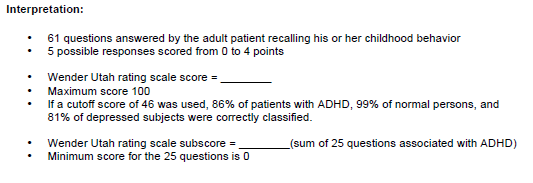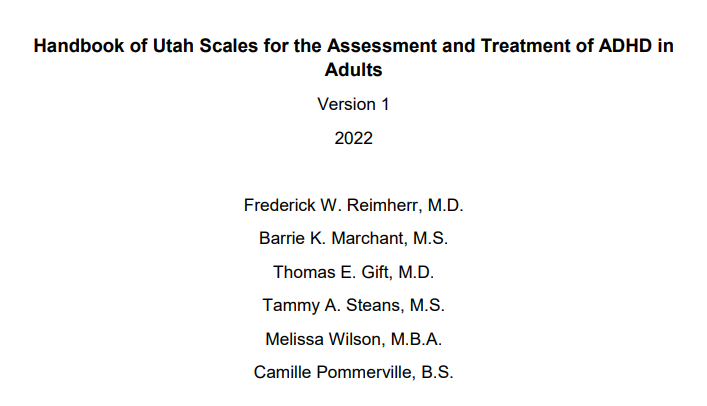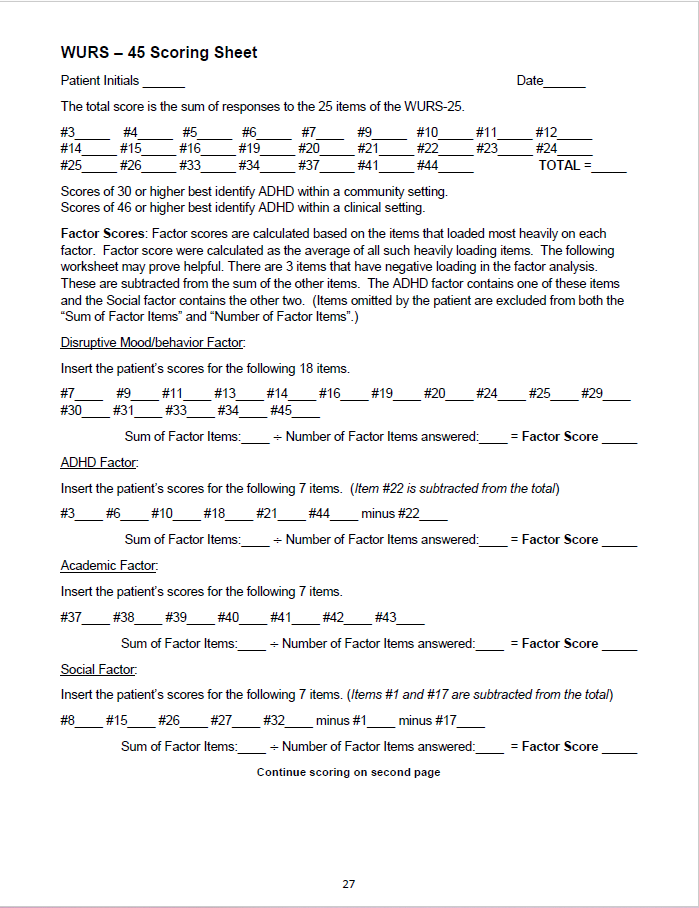- Home
- Wender Utah Scoring
Wender Utah Rating Scale Scoring
Wender Utah Rating Scale Scoring explained.
- Key Points
- What is the Wender Utah Rating Scale?
- Wender Utah Rating Scale Scoring: What You Need to Know
- Wender Utah Rating Scale Interpretation
- WURS-45
- WURS Scorer for WURS-25, 45, & 61
- Why are Fitted Values Important?
- WURS-25 Score vs. WURS-25 Form
- WURS-45 Hand-Scoring Worksheet (image)
- Copyright?
- Terminology
- Researcher? - if you want to conduct research on the WURS ...
- Recommended Reading
Key Points
- The Wender Utah Rating Scale (WURS) is a retrospective self-report of childhood ADHD symptoms used by physicians and other healthcare professionals to screen for possible adult ADHD, and by psychologists as one component of a comprehensive adult ADHD evaluation.
- There are different WURS forms—scoring and interpretation procedures differ depending on which form you use.
- Read the WURS Handbook (manual) to form your own opinion, but I suggest using the WURS-45 because:
(1) You can calculate the original WURS score based on 25 of the 45 items (the WURS-25 score), which works well as a screening test in primary care settings.
(2) And, for differential diagnosis, you can calculate a "fitted value score" from the WURS-45. Calculating the fitted value score takes too long for screening, but is an effective Wender Utah Rating Scale scoring method when used as one component of a comprehensive adult ADHD evaluation conducted by a psychologist. (The fitted value score relies on advanced statistical procedures explained in Gift et al. (2021) - see the Recommended Reading section below.) - Thanks to Michelle Chan, BPsych (Hons) of Adelaide, South Australia, you can download an Excel spreadsheet she created that scores the three primary WURS forms, the WURS-25, WURS-45, and WURS-61.
→ Click here to download the WURS Scorer
→ You must enter the scores from a WURS completed by your patient or client.
→ You will be downloading a zipped folder for technical reasons, but if you open the folder and extract the files, you will find the spreadsheet inside the folder.
The folder URL is: https://www.drworthen.net/support-files/wurs-scorer.zip
→ There should be only one file in the folder:
WURS-Scorer(25, 45, 61).xlsx
→ If you are not sure how to open a ZIP file (or folder), see this guide on wikiHow.com: How to Open a Zip File: 4 Easy Step-by-Step Methods (for Windows, MacOS, iOS, & Android).
What is the Wender Utah Rating Scale?
The Wender Utah Rating Scale (WURS) is a psychological assessment instrument that helps to identify possible ADHD in adults.
A WURS score by itself should not be used to diagnose ADHD.
Psychologists administer the WURS as one component of a comprehensive, multi-method assessment.1
When someone completes the Wender Utah Rating Scale (WURS) they indicate if they experienced educational, psychological, and medical problems during childhood.
Footnote
1. Eid, Michael, and Ed Diener (eds.). Handbook of Multimethod Measurement in Psychology. American Psychological Association, 2006.
Wender Utah Rating Scale Scoring:
What You Need to Know
Here is what you need to know about Wender Utah Rating Scale scoring:
(1) There are several WURS forms. WURS scoring differs depending on which WURS form you use. The most used forms are:
(a) WURS-61 form: the original Wender Utah Rating Scale.
(b) WURS-25 form: Items that comprise a factor associated with ADHD, drawn from the WURS-61.*
(c) WURS-45 form: Forty-five items drawn from the WURS-61.
The WURS-45 is the most psychometrically sound version because it includes only those WURS-61 items that load onto symptom clusters (factors) derived from factor analytic and related statistical analysis.
The WURS-45 also includes all the WURS-25 items, so you can calculate the WURS-25 score when you use the WURS-45 form.
In addition, if you ask people to complete the WURS-25 form, which includes only 25 items, most people realize that they are taking an "ADHD test"—the questionnaire's purpose is transparent. This leads some people to endorse more items at higher severity levels because (for a variety of reasons) they want an ADHD diagnosis.
---
* A factor is "an element or constituent, esp. one which contributes to or influences a process or result." [Oxford English Dictionary, s.v. “factor (n.),” March 2024, https://www.oed.com/dictionary/factor_n] Factor analysis is a statistical procedure used in the field of psychometrics to identify a set of test items that coalesce based on their correlations with a known condition, in this case, ADHD. Thus, 25 items on the WURS-61 score consist
Wender Utah Rating Scale Interpretation
 Scoring instructions found on a popular, free-to-download WURS-61 PDF form
Scoring instructions found on a popular, free-to-download WURS-61 PDF formSummary: Referencing the terms used above, calculate only the subscore. You do not need the score as those terms are used above.
Scoring and interpreting the Wender Utah Rating Scale for Adult ADHD is not as simple as it looks.
For example, consider the interpretation directions in the image above. You will find these instructions on one of the most popular free-to-download WURS-61 PDF forms on the internet.
Note that the form includes space to calculate two scores:
- Wender Utah rating scale score
- Wender Utah rating scale subscore
QUESTION #1: What is the difference between the "Wender Utah rating scale score" and the "Wender Utah rating scale subscore"?
ANSWER #1: Nothing. They are the same thing, at least for the purposes of scoring the Wender Utah Rating Scale as originally designed, i.e., to obtain the WURS-25 score.
QUESTION #2: Why is that potentially confusing?
ANSWER #2: Because, as written, these instructions imply that one should calculate two scores, one based on responses to all 61 items, the "Wender Utah rating scale score", and the second based on the 25 ADHD-specific items, the "Wender Utah rating scale subscore".
However, scoring all 61 items (maximum score = 244) does not produce a meaningful statistic, i.e., it does not tell you anything.
On the other hand, scoring the 25 ADHD-specific items does produce a meaningful statistic: when doctors evaluate patients in a clinic, a WURS-25 score ≥ 46 suggests ADHD.
→ Download the Wender Utah Rating Scale Handbook (manual) for comprehensive, evidence-based recommendations, and use the WURS-61 Scoring Sheet on pages 18–19.
→ While you're there, read about the WURS-45, which is the most efficient form of the test.
WURS-45
Download a "clean" version of the WURS-45. By clean, I mean the introduction and asterisks are removed.
→ Click here to download the WURS-45.
Or use the WURS-45 in the WURS Handbook on pages 23–24.
Score WURS-45 by Hand or Spreadsheet
Wender Utah Rating Scale scoring can be cumbersome. While online administration and scoring programs exist for the WURS-25 score, I have yet to find such online programs that calculate factor scores and fitted values from the WURS-45 or WURS-65. (See Why are Fitted Values Important?, below.)
You can score the WURS-45 by hand, using the scoring sheet on page 27 of the Handbook.
Or use the WURS Scorer spreadsheet - info immediately below.
WURS Scorer for WURS-25, 45, & 61
Michelle Chan, BPsych (Hons), Bridge Consulting Psychologists (Australia), created a user-friendly Excel spreadsheet that automatically calculates:
- WURS-25 score (calculated from any of the three main WURS forms: 25, 45, or 61);
- Factor scores (from the WURS-45 or WURS-61); and
- Fitted values (from the WURS-45 or WURS-61).
→ Click here to download the WURS Scorer
→ You will be downloading a zipped folder for technical reasons, but if you open the folder and extract the files, you will find the spreadsheet inside the folder. The folder URL is:
https://www.drworthen.net/support-files/wurs-scorer.zip
→ There should be only one file in the folder:
WURS-Scorer(25, 45, 61).xlsx
→ If you are not sure how to open a ZIP file (or folder), see this guide on wikiHow.com: How to Open a Zip File: 4 Easy Step-by-Step Methods (for Windows, MacOS, iOS, & Android).
Note: You must enter the item responses from a WURS completed by your patient or client. I have yet to see an online WURS scoring program that calculates factor scores and fitted values for the WURS-45 and WURS-61.
Thank you to Michelle for graciously sharing this easy-to-use Wender Utah Rating Scale scoring spreadsheet!
Why are Fitted Values Important?
Calculating fitted values can help differentiate between ADHD-like symptoms caused by depressive and anxiety disorders vs. ADHD-driven symptomatology.
As you probably know, substantial overlap exists between symptoms for ADHD, depression, anxiety, and other disorders, e.g., difficulty concentrating.
In other words, a patient with major depression and generalized anxiety may look like they have ADHD.
The three disorders can coexist but the prevalence of ADHD + MDD + GAD is much lower than MDD + GAD.
Of course, one should not diagnose based on fitted values alone.
WURS-25 Score vs. WURS-25 Form
A WURS-25 score effectively screens for adult ADHD in primary care clinics, but for more nuanced evaluation, including differential diagnosis with depressive and anxiety disorders, one should calculate factor scores and fitted values from the WURS-45 or WURS-61. See the WURS Handbook (manual) for details.
→ I italicize score in "WURS-25 score" because there is also a WURS-25 form that contains only the 25 items found to identify possible adult ADHD in the original 1980s WURS research. If you use the WURS-25 form, it will yield a WURS-25 score, but you can also obtain the WURS-25 score from completed WURS-45 or WURS-61 forms.
The WURS-25 form, if presented as an "ADHD test" (an inappropriate term) or an "ADHD screening instrument" will prime some patients to endorse more items if they think they have ADHD, or if they seek an ADHD diagnosis for specific reasons, e.g., to obtain stimulant medication.
I therefore suggest either not telling patients the purpose of the WURS-25 form until after they complete it (although if they insist on knowing in advance, you should tell them) or, better yet, administer the WURS-45 because that version will give you a WURS-25 score and fitted value scores.
WURS-45 Hand-Scoring Worksheet (image)
Download the Wender Utah Rating Scale Handbook
→ Click here to download the Wender Utah Rating Scale Handbook.
You can also access the Wender Utah Rating Scale Handbook at: perma.cc/F4VS-TMU5.
Copyright?
The WURS Handbook is licensed under CC BY-NC-ND 4.0 (Attribution-NonCommercial-NoDerivs 4.0 International).
Please read about what that means on the Creative Commons website.
Terminology
- "WURS-25" refers to both a scoring method and a form, which is confusing. I therefore use the terms "WURS-25 scoring" (or "WURS-25 score") and "WURS-25 form" for clarity.
- "ADHD-specific items" also has two meanings:
- In the original (1980s) Wender Utah Rating Scale research, 25 out of the original 61 items were found to best distinguish adults with ADHD from adults who did not have ADHD. Those 25 items appear on the WURS-25 form and they are embedded in the WURS-45 and WURS-61 forms.
Regardless of their source, those 25 items constitute the (original) WURS score, which I refer to as the "WURS-25 score" to distinguish the score from the "WURS-25 form". - More recent research has identified items that load onto an ADHD factor (based on factor analytic research). This ADHD factor score is used in a regression formula to calculate a "fitted value" score, which is a more sophisticated statistical approach to WURS scoring that helps psychologists to differentiate adult ADHD from other mental disorders that have many of the same symptoms.
For example, Major Depressive Disorder, PTSD, Generalized Anxiety Disorder, and ADHD all include "difficulty concentrating" (or similar) in their diagnostic criteria.
Researcher?
If you are a physician, psychologist, or other scientific investigator interested in conducting research on the Wender Utah Rating Scale (WURS), I encourage you to contact one of the leading WURS researchers for consultation or to answer questions:
BARRIE K MARCHANT
611 N 26TH ST
LINCOLN NE 68503-3030
email: barriemarchant[at]aol[dot]com
Recommended Reading
Brevik, Erlend Joramo, Astri J. Lundervold, Jan Haavik, and Maj‐Britt Posserud. "Validity and Accuracy of the Adult Attention‐Deficit/Hyperactivity Disorder (ADHD) Self‐Report Scale (ASRS) and the Wender Utah Rating Scale (WURS) Symptom Checklists in Discriminating Between Adults with and without ADHD." Brain and Behavior 10, no. 6 (Apr 2020): e01605.
Gift, Thomas E., Matthew L. Reimherr, Barrie K. Marchant, Tammy A. Steans, and Frederick W. Reimherr. "Wender Utah Rating Scale: Psychometrics, Clinical Utility and Implications Regarding the Elements of ADHD." Journal of Psychiatric Research 135 (2021): 181-188.
Marchant, Barrie K., Fred W. Reimherr, Diane Robison, Reid J. Robison, and Paul H. Wender. "Psychometric properties of the Wender-Reimherr Adult Attention Deficit Disorder Scale." Psychological Assessment 25, no. 3 (2013): 942.
Reimherr, Frederick W., Barrie K. Marchant, Thomas E. Gift, Tammy A. Steans, and Matthew L. Reimherr. "Psychometric Data and Versions of the Wender Utah Rating Scale including the WURS-25 & WURS-45." Data in Brief 37, art. no. 107232 (Aug 2021).
Reimherr, Frederick W., Barrie K. Marchant, Thomas E. Gift, Tammy A. Steans, Melissa Wilson, and Camille Pommerville. Handbook of Utah Scales for the Assessment and Treatment of ADHD in Adults. Version 1, 2022. https://perma.cc/F4VS-TMU5.
Ward, Mark F., Paul H. Wender, and Fred W. Reimherr. "The Wender Utah Rating Scale: An Aid in the Retrospective Diagnosis of Childhood Attention Deficit Hyperactivity Disorder." American Journal of Psychiatry 150, no. 6 (1993): 885-890.
Historical Interest:
Ward, Mark F. "The Wender Utah Rating Scale: an Aid in the Retrospective Diagnosis of Childhood Attention Deficit Hyperactivity Disorder." American Journal of Psychiatry 150 (1993): 885-885.
Wender, Paul H., Frederick W. Reimherr, and David R. Wood. "Attention Deficit Disorder ('Minimal Brain Dysfunction') in Adults: a Replication Study of Diagnosis and Drug Treatment." Archives of General Psychiatry 38, no. 4 (1981): 449-456.
Wood, David R., Frederick W. Reimherr, Paul H. Wender, and Glen E. Johnson. "Diagnosis and Treatment of Minimal Brain Dysfunction in Adults: a Preliminary Report." Archives of General Psychiatry 33, no. 12 (1976): 1453-1460.
What Do You Think?
I value your feedback!
If you would like to comment, ask questions, or offer suggestions about this page, please feel free to do so. Of course, keep it clean and courteous.
You can leave an anonymous comment if you wish–just type your first name.
If you want to receive an email when someone replies to your comment, click the icon on the lower right of the comment box to use Google Sign-in. (Your email remains private.)
Important: Do not type your email address or other identifying information into your comment as it will appear on the Internet for everyone to see ... and for spam bots to harvest so that spammers can sell your email address to other spammers.
How did you build this website?
I used Solo Build It! to build this website in 2004 and still use it today, especially for the extremely helpful business guidance and the superior search engine optimization.
Note: If you click on one of these links and you decide to purchase Solo Build It! I earn a small affiliate commission. Your cost is the same either way. If you do not want me to earn an affiliate commission, just google "solo build it".





